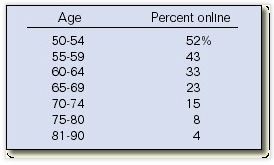The Pew Internet & American Life Project recently released the results of a survey on Internet usage among American seniors. “Wired Seniors: A fervent few, inspired by family ties,” principally authored by Susannah Fox, is available at http://www.pewinternet.orgreports/pdfs/PIP_Wired_Seniors_Report.pdf.
The report provides findings that may be of special interest to those who are responsible for encouraging planned gifts from Americans over the age of 65. It is critical to have an understanding of this age group as studies indicate that most persons who leave bequests to charity execute the will that leaves the bequest when they are in their late seventies and then pass away in their early eighties. In addition, the typical gift annuitant is a woman in her mid to late seventies, and charitable remainder trust donors tend to be in the 65-to-85 age range as well. Learning about Internet usage among this age group may help fine tune marketing efforts in this rapidly expanding realm of communication.
Internet usage
Although the Internet has become an integral part of everyday life for many Americans, this is not the case for those over 65. Seniors represent 13% of the U.S. population, but only 4% of seniors are considered to be “wired.” 56% of Americans overall have access to the Internet, compared to only 15% of those over 65. Only 6% of those over 65 plan to definitely go online in the future, and some 56% project they never will. Contrast this with the 51-64 age group, among whom 51% have Internet access.
Note the breakdown by age of Americans who use the Internet.

The Pew report indicates that prior computer usage in school or the work place appears to be a primary factor in whether and if persons ever go online, a fact that explains the higher interest among the younger group. Economics also appear to be a factor underlying the decision not to go online, as many seniors expressed concerns about high monthly access fees. Vision problems that may preclude extended periods in front of a computer screen may also limit computer use among older Americans. Very few seniors indicate an interest in conducting business via the Internet, and most are wary of supplying personal information online. As a general rule, they also consider it to be an invasion of privacy for businesses to obtain information about them online without their knowledge.
Mixed messages
So, should fundraisers utilize the web to communicate with seniors? For the time being, all indications are that the primary method of communicating gift planning ideas to seniors should remain printed materials. According to the Pew report, 57% of Americans over 65 read newspapers every day, compared with 40% of the general population. The report also indicates that women over 70, who make up most of the traditional market for planned gifts, are not online now and most have indicated they plan never to pursue the Internet as means of communication or as an information source. The generation following behind, however, can be expected to remain avid users of the Internet for all sorts of activities, including charitable giving. The primary benefit of the Internet in fundraising for the time being may well lie in the acquisition and cultivation of baby boomers and others among the younger population. Use this medium to encourage the younger members of your constituency to support charitable causes of all types—and give them the information they need to better plan their gifts. You may want to promote gifts of appreciated assets, term-of-years gift plans, life income gifts for others, and other gifts that primarily appeal to the 45-to-65 age group. You could also consider including “teaser” banners that offer gift planning information along with mission-related copy on your Web site.
The Internet offers many exciting opportunities for fundraisers, not the least of which is the ability to better inform donors about the best ways to make their gifts—now and in future years.
Editor’s note: To gain perspective on how online activities of Americans have changed in the last four years, refer to “Untangling the Web—Should Charities Be on the Internet?,” featured in the September 1998 issue of Give & Take. See www.rfsco.com/gt for details.

